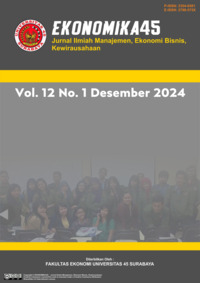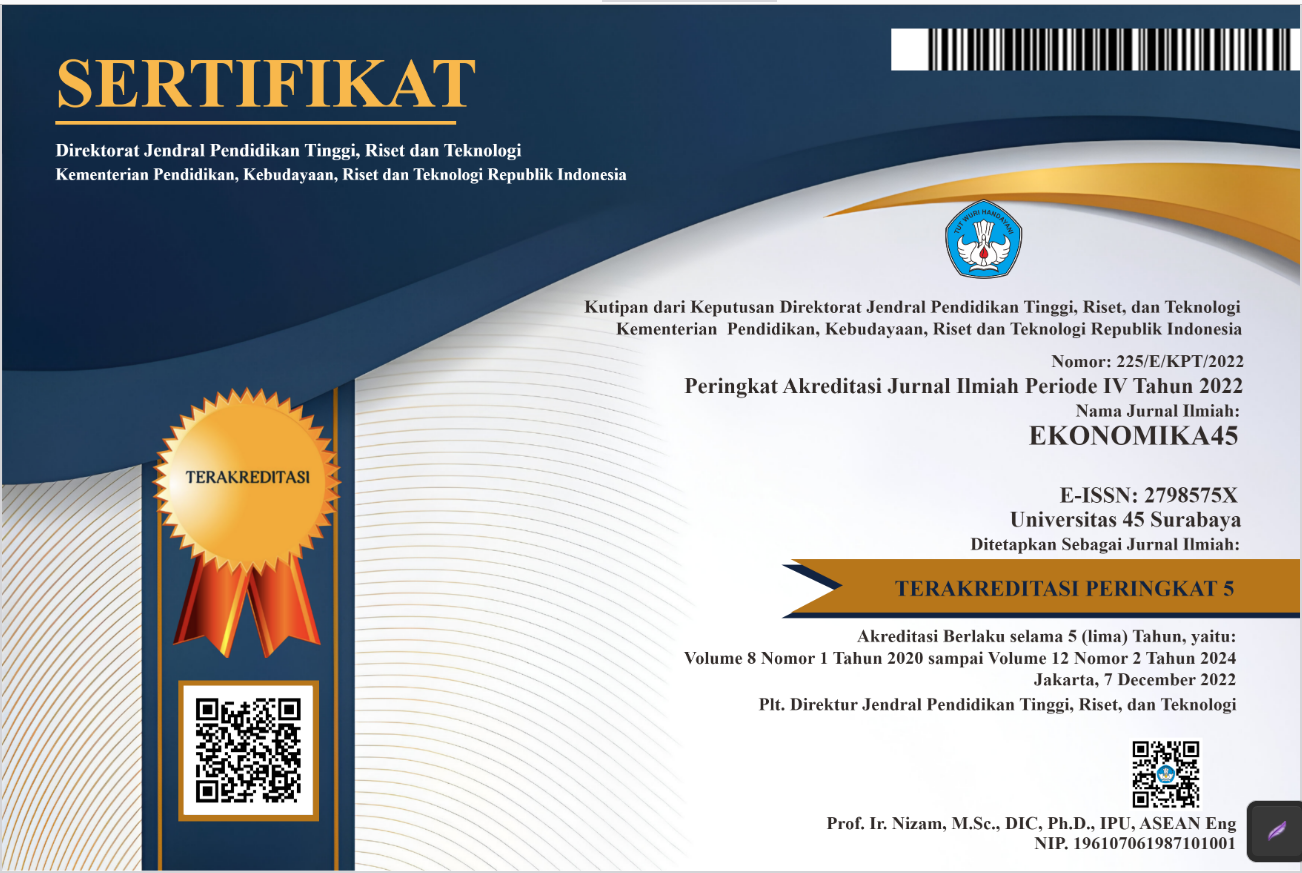Analisis Tata Letak Gudang Produksi di PT Nusantara Sejahtera Medica
DOI:
https://doi.org/10.30640/ekonomika45.v12i1.3624Keywords:
Warehouse Layout, Operational Efficiency, Production ProcessAbstract
Tight business competition encourages companies to manage resources optimally and create competitive advantages. Operations management, which includes managing inputs, processes, and outputs, plays an important role in achieving these goals. Warehouses are an important part of a company's supply chain, functioning as a place to store goods inventory and support the smooth production and operational processes. Optimal warehouse layout influences smooth operations, optimizes space, and supports the production process. PT Nusantara Sejahtera Medica is a company engaged in the production of organic fertilizer and health supplements in West Bandung Regency, currently using a "play out by process" system in its warehouse. This system is considered less than optimal and needs to be reviewed to improve operational effectiveness. This research aims to analyze the layout of the production warehouse and how efficient it is in the production process at PT Nusantara Sejahtera Medica to increase operational effectiveness. This research use desciptive qualitative approach. Data was obtained from direct observation, interviews and documentation. The research results show that PT Nusantara Sejahtera Medika implements a "play out by process" layout in its warehouse, aiming to minimize material handling costs and maximize storage space. However, there are problems such as delays in work activities caused by damage to machines and boxes, which hamper the production process. Apart from that, at PT Nusantara Sejahtera Medika, there are three main warehousing activities, including movement, storage and information transfer. Although the company had implemented FIFO inventory management methods, the outdated warehouse layout and less innovative communication system indicated the need for a review to improve operational efficiency.
References
Adiyanto, O., & Clistia, A. F. (2020). Perancangan ulang tata letak fasilitas produksi UKM Eko Bubut dengan metode Computerized Relationship Layout Planning (CORELAP). JISI: Jurnal Integrasi Sistem Industri, 7(1), 49–56.
Amri, Bahri, S., & Geni, P. L. (2021). Perencanaan ulang tata letak gudang material bahan baku dengan menggunakan metode Shared Store dan pendekatan simulasi pada PT. Aini Sejahtera. Industrial Engineering Journal, 10(1).
Audrey, O., Wayan, S., & Rohana, S. (2019). Analisis tata letak gudang dengan menggunakan metode Dedicate Storage. Jurnal ASIIMETRIK: Jurnal Ilmiah Rekayasa & Inovasi, 1(1), 43–49.
Aziz Sholeh, A., et al. (2024). Kompensasi terhadap motivasi kerja karyawan pada PT. Insolent Raya di Surabaya. Journal of Management and Creative Business, 2(1), 82–96.
Bart, B. (2002, October 14). Going faster. Globe and Mail, sec. A, p. 1.
Chaerul, A., Arianto, B., & Bhirawa, W. T. (2021). Perancangan ulang tata letak fasilitas Cafe "Home 232" Cinere. Jurnal Teknik Industri, 8(2), 142–158.
Fadhilah, F., Suryawan, R. F., & Lestari, L. (2022). Teori gudang digunakan dalam proses pergudangan (Tinjauan empat aspek). Jurnal Transportasi, Logistik, dan Aviasi, 1(2), 153–156.
Fajri, A. (2021). Perancangan relokasi tata letak gudang dengan menggunakan metode Systematic Layout Planning pada PT. MKM KRA-ITH. Jurnal Sains dan Teknologi, 5(1), 32–43.
Febriani, N. F., & Nafiah, R. (2018). Perbaikan tata letak fasilitas untuk efisiensi pemindahan bahan di PT. Adi Satria Abadi Yogyakarta. Berkala Penelitian Teknologi Kulit, Sepatu, dan Produk Kulit, 17(1), 46–56.
Haikal, M. H., & Rahmawati, N. (2024). Perencanaan tata letak gudang menggunakan metode Class-Based Storage di PT. XYZ. Jurnal Cakrawala Ilmiah, 3(5), 1371–1384.
Heizer, J., & Render, B. (2015). Manajemen operasi: Manajemen keberlangsungan dan rantai pasokan. Jakarta: Salemba Empat.
Indonesia, P. T. (2024). Toyota Production System (TPS) merupakan sistem produksi yang bertujuan untuk menghapuskan seluruh limbah dalam mencapai efisiensi. Diambil kembali dari TOYOTA INDONESIA: https://www.toyota.co.id/industrial/tps
Kristiawati, et al. (2019). Citra merek, persepsi harga, dan nilai pelanggan terhadap keputusan pembelian pada mini market Indomaret Lontar Surabaya. Jurnal Ilmu Ekonomi dan Manajemen (JMM 17), 6(2), 27–36.
Purnomo, H. (2004). Perencanaan dan perancangan fasilitas. Yogyakarta: Graha Ilmu.
Redaksi. (2014, Desember 19). Strategi manajemen inventori, rahasia produk murah IKEA? (Bagian II). Diambil kembali dari SHIFT Indonesia Your Operational Excellence Guide: https://shiftindonesia.com/strategi-manajemen-inventori-rahasia-produk-murah-ikea-bagian-ii/
Sujarweni, V. W. (2018). Metodologi penelitian bisnis dan ekonomi. Yogyakarta: Pustaka Baru.
Toronto Star. (2003, November 12). Telehealth in Alberta. Toronto Star, sec. G, pp. 1–3.
Wekke, I. S. (2019). Metode penelitian sosial. Yogyakarta: CV Adi Karya Mandiri.
Wijayanti, P., & Sunriwiyati, S. (2019). Analisis pengendalian persediaan bahan baku guna memperlancar proses produksi dalam memenuhi permintaan konsumen pada UD Aura Kompos. Jurnal Penelitian Manajemen Terapan (PENATARAN), 4(2), 179–190.
Downloads
Published
How to Cite
Issue
Section
License
Copyright (c) 2024 EKONOMIKA45 : Jurnal Ilmiah Manajemen, Ekonomi Bisnis, Kewirausahaan

This work is licensed under a Creative Commons Attribution-ShareAlike 4.0 International License.









